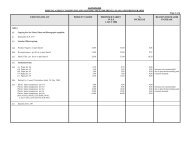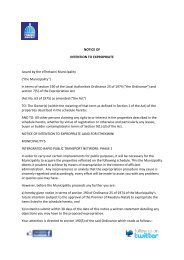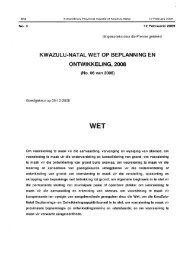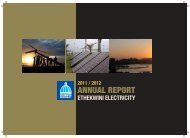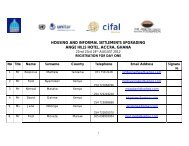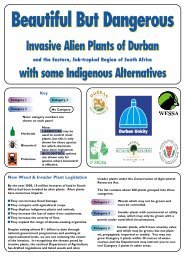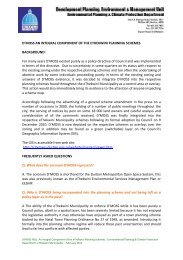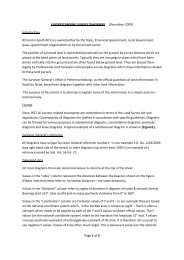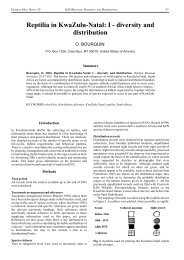Mullin, S. K., Taylor, P. J. & Pillay, N. 2004. Skull size and ... - Durban
Mullin, S. K., Taylor, P. J. & Pillay, N. 2004. Skull size and ... - Durban
Mullin, S. K., Taylor, P. J. & Pillay, N. 2004. Skull size and ... - Durban
You also want an ePaper? Increase the reach of your titles
YUMPU automatically turns print PDFs into web optimized ePapers that Google loves.
MULLIN_08 13/08/04 12:45 Page 32<br />
<strong>Mullin</strong> S. K. et al.<br />
REMARKS. — Cranial measurements for type are not<br />
available. The type skull, deposited in the Museum of<br />
Natural History, London, is not intact. An allotype<br />
must be designated. Although it has a similar skull to<br />
D. medius (perhaps due to the small sample <strong>size</strong> for<br />
this species in this study), we feel that its dark pelage,<br />
short tail, small cranial <strong>and</strong> external measurements <strong>and</strong><br />
its restriction to high altitudes confirms its species status.<br />
Dasymys montanus has been recorded from 3000 m<br />
while D. medius is found closer to 1000 m.<br />
Dasymys nudipes (Peters, 1970)<br />
Jornal de sciencias mathematicas, physicas e naturaes,<br />
series 1 3: 126.<br />
TYPE LOCALITY. — Huila, Angola.<br />
SPECIMENS EXAMINED. — Angola (Dondi, Huila,<br />
Humpata).<br />
DIAGNOSIS. — Dasymys nudipes generally has a larger<br />
<strong>size</strong> (both external <strong>and</strong> cranial) than all of the specimens<br />
examined. Distinguishing features include a significantly<br />
longer tail, hind foot, total body length <strong>and</strong><br />
head-body/tail ratio in addition to the following cranial<br />
characters: condylobasal length, upper toothrow,<br />
hard palate width, zygomatic arch width, braincase<br />
breadth, internal diameter of the zygomatic arch, foramen<br />
magnum width, m<strong>and</strong>ible length, maxillary<br />
toothrow <strong>and</strong> incisor to condyle length. Also,<br />
D. nudipes appears to be the only Dasymys species with<br />
a longer tail than body length. Its skull is most similar<br />
to D. capensis <strong>and</strong> is significantly distinct from the<br />
other nine species examined.<br />
REMARKS. — Restricted to the southwestern plateaus<br />
of Angola.<br />
Dasymys robertsii n. sp.<br />
HOLOTYPE. — TM40249; skin <strong>and</strong> skull; adult male;<br />
collected by Bronner et al. on August 24, 1988.<br />
TYPE LOCALITY. — Klipfontein, 30 km NE Vaalwater,<br />
Waterberg; 1091 m, South Africa.<br />
SPECIMENS EXAMINED. — The Limpopo <strong>and</strong><br />
Mpumlanga Provinces of South Africa (Punda Milia,<br />
Soutpansberg, Tzaneen, Potgietersrus, Klipfontein,<br />
P R O O F<br />
Nylsvlei, Pretoria, Vaalwater, Barberton, Gladdespruit,<br />
Arnhemburg, de Hoop Private Nature Reserve,<br />
Lydenburg, Hectorpsruit), eastern Botswana (Kasane)<br />
<strong>and</strong> western/northwestern Zimbabwe (Nyamnyetsi,<br />
Chinyika River, Harare, Chibeto, Umtali <strong>and</strong> Troutbeck<br />
Lake).<br />
ETYMOLOGY. — The name “robertsii” honours A.<br />
Roberts who was the first to suggest that Limpopo <strong>and</strong><br />
Mpumalanga D. incomtus were separate from<br />
KwaZulu-Natal Province D. incomtus; however,<br />
Roberts (1951) did not provide an accession number<br />
or a description of the “type” for Limpopo <strong>and</strong><br />
Mpumalanga specimens he mentioned.<br />
DIAGNOSIS. — Dasymys robertsii n. sp. is generally<br />
smaller in <strong>size</strong> than D. incomtus from the KwaZulu-<br />
Natal Province. Its skull is most similar to material<br />
representing D. foxi, D. incomtus from the KwaZulu-<br />
Natal Province <strong>and</strong> D. griseifrons. Dasymys robertsii n.<br />
32<br />
sp. is most distinct from D. rufulus, D. nudipes <strong>and</strong><br />
D. longipilosus. St<strong>and</strong>ard measurements of the skull:<br />
GSL = 36.81, UTR = 7.64, PWM = 3.22, NAS = 4.17,<br />
ZYN = 13.04, BBC = 14.17, FRO = 14.27, IOB = 4.61,<br />
FMW = 5.72, UMW = 1.31, ZPW = 4.43, GML<br />
= 27.49, MTR = 7.30, GHS = 11.60, HB = 157 mm,<br />
TL = 135 mm, HF = 35.0 mm, E = 21.0 mm, TOT<br />
= 292, M = 102 g, HB/TL ratio = 85.99%.<br />
REMARKS. — Tissue samples for the type specimen are<br />
in storage at the TM museum. Dasymys robertsii n. sp.<br />
is not similar to D. incomtus from the KwaZulu-Natal<br />
Province, confirming genetic studies (Gordon 1991;<br />
<strong>Mullin</strong> et al. 2002).<br />
Dasymys rufulus Miller, 1900<br />
Proceedings of the Washington Academy of Sciences 2: 639.<br />
TYPE LOCALITY. — Mount Coffee, Liberia (MCZ).<br />
SYNONYMS. — Dasymys incomtus alleni Lawrence &<br />
Loveridge, 1953: Bulletin of the Museum of<br />
Comparative Zoology at Harvard College 100 (1): 53.<br />
Ilolo, Mount Rungwe, southwestern Tanzania;<br />
Dasymys bentleyae Thomas, 1892, Ngombe, Zaire.<br />
Mus (Dasymys) incomtus bentleyae Thomas, 1892:<br />
Annals <strong>and</strong> Magazines of Natural History 10 (6): 179.<br />
Dasymys incomtus edsoni Hatt, 1934: American<br />
Museum Novitates 708: 6. Lukolela, Middle Congo<br />
(Democratic Republic of Congo).<br />
SPECIMENS EXAMINED. — Senegal, Guinea, Sierra<br />
Leone, Liberia, southern Mali, Burkina Faso, Ivory<br />
Coast, Ghana, Togo, Benin, Nigeria, Southern Chad,<br />
southern Sudan, Cameroon, Central African Republic,<br />
Congo, western <strong>and</strong> northern Democratic republic of<br />
Congo (Bagbele, Bukarabwa, Faradje, Kinshasha,<br />
Likouala, Lubumbashi, Lukolela, Luluabourg,<br />
Nambira, Nambirima, Ngombe), Tanzania, northern<br />
Angola (Chitau, Dundo, Duque de Braganca,<br />
Mombolo), Zambia, Malawi <strong>and</strong> Mozambique.<br />
DIAGNOSIS. — Dasymys rufulus has a significantly<br />
smaller zygomatic plate width, m<strong>and</strong>ible length, incisor<br />
to condyle length <strong>and</strong> skull height than the other<br />
10 groups examined. It is most similar to D. medius<br />
<strong>and</strong> D. foxi in terms of its overall skull <strong>size</strong>. The skull<br />
of D. rufulus is most distinct from D. nudipes,<br />
D. capensis, D. longipilosus <strong>and</strong> D. shortridgei.<br />
REMARKS. — Dasymys rufulus appears to be part of a<br />
species complex that includes material from central<br />
(Cameroon, CAR, DRC, northern Angola, Zambia)<br />
<strong>and</strong> east Africa (Tanzania, Malawi <strong>and</strong> Mozambique).<br />
Dasymys shortridgei n. sp.<br />
HOLOTYPE. — AM5899; skin <strong>and</strong> skull; adult male;<br />
collected by G.C. Shortridge on June 28, 1929.<br />
TYPE LOCALITY. — Okavango-Omatako, Grootfontein;<br />
1080m, Namibia.<br />
SPECIMENS EXAMINED. — Botswana (Boro Isl<strong>and</strong>,<br />
Moremi) <strong>and</strong> Namibia (Diwai, Gangongo, Mohango<br />
Drift, Okavango-Omatako Junction, Sinjemba).<br />
ETYMOLOGY. — The name shortridegei honours G.C.<br />
Shortridge as he collected the majority of the Dasymys<br />
specimens from the Okavango Delta.<br />
MAMMALIA • 2004 • 68 (2)


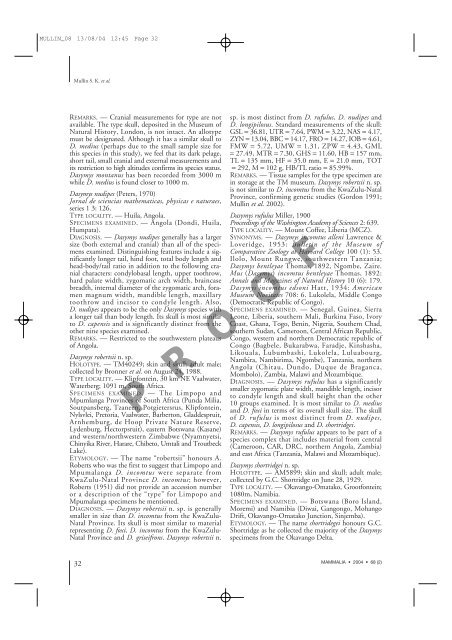
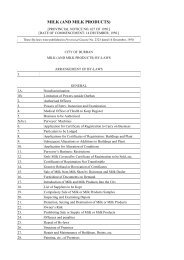
![INK Environmental Sustainability Booklet [19 MB] - Durban](https://img.yumpu.com/22025104/1/190x136/ink-environmental-sustainability-booklet-19-mb-durban.jpg?quality=85)

